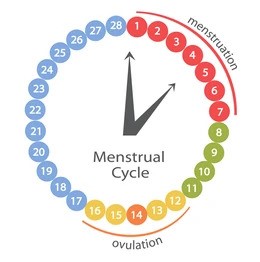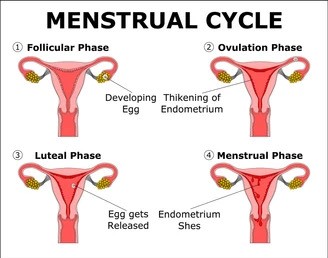This blog delves into the menstrual cycle, a cornerstone of women’s health. Far from being a monthly event, it’s a complex interplay of biological processes integral to understanding the natural rhythm affecting a woman’s body, mind, and lifestyle. The menstrual cycle transcends its reproductive role as a marker of overall health and well-being. Each phase ushers in unique changes, impacting mood, energy, fitness, and nutritional needs. Through understanding these cycles, women can optimise their health, tailor their activities, and maintain balance.
We’ll explore the cycle’s purpose, critical role in health, various phases, and the bodily changes it brings. The focus will also be on tailoring diet and workouts to these phases and understanding the cycle’s influence on weight and hormones. This blog goes beyond biology; it’s about empowering oneself with knowledge to live in harmony with one’s body.
The Science Behind the Menstrual Cycle
The menstrual cycle is a natural biological cycle that results in a woman’s reproductive system being prepared for pregnancy every month. It is a series of harmonic hormonal fluctuations conducted by the brain, ovaries, and uterus. The process begins with the first day of menstruation and ends with a new period’s onset; the cycle lasts about 28 days on average but may vary from woman to woman.

The cycle is divided into several phases, each with specific hormonal changes. Initially, the brain signals the ovaries to prepare eggs for release. Midway through the cycle, ovulation occurs – the release of a mature egg ready for fertilisation. If fertilisation doesn’t occur, the uterus sheds its lining, leading to menstruation, and the cycle begins anew. This rhythm is not just about reproduction; it’s a vital sign of a woman’s overall health and bodily harmony.
Its Importance
The menstrual cycle is a window into a woman’s health. Regular cycles often indicate a healthy balance of hormones, essential not just for fertility but for overall well-being. Hormones like estrogen and progesterone, which play key roles in the menstrual cycle, also influence bone health, cardiovascular function, and mood regulation. Irregularities in the cycle can signal underlying health issues such as hormonal imbalances, thyroid problems, or other medical conditions.
The menstrual cycle is a monthly report card of a woman’s health.
Phases of the Menstrual Cycle
Understanding the menstrual cycle involves breaking it down into four distinct phases.

Menstrual Phase:
The menstrual phase marks the beginning of the cycle. It starts on the first day of menstruation and usually lasts 3 to 7 days. This phase begins when an egg from the previous cycle isn’t fertilised, signalling the body to shed the uterine lining.
The uterine lining sheds during menstrual bleeding, and hormone levels of estrogen and progesterone are low during this time. The body expels tissues and blood from the uterus, which can cause symptoms like cramps and discomfort.
Follicular Phase:
Post-menstruation, the pituitary gland releases follicle-stimulating hormone (FSH), which stimulates the ovaries to produce follicles. One of these follicles will mature into an egg. As the follicular phase progresses, estrogen levels rise, leading to the rebuilding of the uterine lining. This phase typically lasts until ovulation and is crucial for preparing the body for a potential pregnancy. LH levels are relatively low.
Ovulation:
The release of a mature egg around the middle of the cycle marks ovulation. The exact timing can vary, but it’s generally around day 14 in a 28-day cycle. LH surge is the big moment! It’s like the drumroll before the main act. A rapid increase in LH triggers ovulation, releasing the matured egg from the ovary into the fallopian tube. Signs of ovulation include a slight rise in basal body temperature and changes in cervical mucus, which becomes clearer, akin to egg whites.
Luteal Phase:
Post-ovulation, the ruptured follicle closes, LH levels decrease, and the empty follicle transforms into the corpus luteum, which produces progesterone. This hormone supports a potential pregnancy by thickening the uterine lining for a possible pregnancy. If fertilisation doesn’t occur, hormone levels fall, leading back to menstruation, thus completing the cycle.
Body Changes and Symptoms
Each phase of the menstrual cycle brings distinct physical and emotional changes. Let’s dive in from bloating and mood swings to heightened energy levels.
Menstrual Phase: Shedding and Renewal
Physical Changes: The most evident symptom is menstrual bleeding. Due to the contraction of uterine muscles and the shedding process, women may also experience cramps, bloating, lower back pain, and fatigue.
Emotional Changes: Mood swings, irritability, and feelings of sadness or emotional sensitivity are common. It’s crucial to understand that these mood fluctuations are normal and a result of hormonal changes.
Misconceptions: There’s a common myth that women are incapable of certain activities during menstruation. In reality, many can continue their routine activities, albeit with some adjustments for comfort.
Follicular Phase: Building Up
Physical Changes: As estrogen levels rise, many women notice increased energy, reduced bloating, and a general feeling of well-being. The body is preparing for ovulation, and some may experience heightened senses.
Emotional Changes: This phase often boosts mood, increases libido, and creates a feeling of optimism, which correlates with rising estrogen levels.
Misconceptions: A common misunderstanding is that this phase is symptom-free. While it’s generally a time of increased energy and mood, individual experiences can vary greatly.
Ovulation: The Fertile Window
Physical Changes: Some women may experience mild pelvic pain, increased cervical mucus, and slightly increased basal body temperature.
Emotional Changes: Many report feeling more confident and socially inclined during this phase, possibly an evolutionary trait linked to the body’s fertility.
Misconceptions: A prevalent myth is that ovulation always occurs precisely on day 14. The timing of ovulation can vary greatly among women and even from cycle to cycle.
Luteal Phase: The Waiting Period
Physical Changes: Symptoms can include breast tenderness, bloating, headaches, and changes in appetite due to the increase in progesterone. Some women may experience premenstrual syndrome (PMS).
Emotional Changes: The luteal phase is often associated with mood swings, irritability, and sometimes anxiety or depressive symptoms as hormone levels fluctuate.
Misconceptions: PMS is often exaggerated in popular culture. While it’s true that some women experience significant discomfort, others may have mild or no symptoms.
Nutrition for Each Phase
Nutrition plays a critical role in managing the effects of the menstrual cycle on the body. Each phase has different nutritional needs, and tailoring your diet accordingly can help alleviate symptoms and maintain overall health.
Menstrual Phase: Nourishing and Replenishing
Iron-rich foods: During menstruation, women lose blood and, consequently, iron. Including iron-rich foods like leafy greens, lean meats, lentils, and fortified cereals can help replenish iron stores.
Hydration: Menstrual fluid loss can lead to dehydration. Drinking plenty of water, herbal teas, and hydrating fruits like watermelon and cucumber can help maintain hydration.
Follicular Phase: Building Energy and Health
Balanced Diet: This phase is all about building up. Focus on a balanced diet with carbohydrates for energy, lean protein for muscle repair, and healthy fats for hormonal balance. Whole grains, nuts, lean meats, and fruits and vegetables are excellent choices.
Energy-Boosting Foods: Foods like oats, bananas, and yoghurt can provide sustained energy, helping to keep energy levels consistent as the body prepares for ovulation.
Ovulation: Peak Fertility Nourishment
Focus on Fiber: High-fiber foods can help the body manage the hormonal changes during ovulation. Include foods like berries, whole grains, and leafy greens.
Maintaining Hydration: Continue with a high fluid intake. This helps with the overall feeling of well-being and can aid in managing any ovulation-related symptoms, like bloating.
Luteal Phase: Comfort and Symptom Management
Managing Cravings: It’s common to experience cravings during this phase. Eating healthier alternatives to satisfy sweet or salty cravings can help maintain a balanced diet.
Magnesium-Rich Foods: Foods high in magnesium, such as dark chocolate, avocados, nuts, and seeds, can help alleviate cramps and muscular tension often associated with this phase.
Workout Recommendations
Exercise is a powerful tool for managing menstrual cycle symptoms. Adapting your workout routine to the different phases of your cycle can enhance well-being and optimise health.
Menstrual Phase: During menstruation, low-impact activities like walking, yoga, or light stretching can be beneficial. They help manage cramps and boost mood without putting too much strain on the body.
Follicular Phase: As energy levels rise, this is a great time for more vigorous activities. High-intensity interval training (HIIT), strength training, and cardio workouts can be more comfortably managed and capitalise on the increased energy.
Ovulation: The body is at its peak strength during ovulation. This is an excellent time for challenging workouts, including heavy lifting, intense cardio, or yoga poses.
Luteal Phase: As energy may dip, switching to moderate exercises like brisk walking, light cycling, or Pilates can be more suitable. These activities can help manage premenstrual symptoms and maintain a positive mood.
Menstrual Cycle, Weight, and Hormones
Weight Fluctuations and Water Retention: Hormonal changes throughout the cycle can lead to temporary weight gain and water retention, especially in the luteal phase. This is a normal part of the cycle and typically resolves after menstruation begins.
Hormonal Influence on Weight and Mood: Hormones like estrogen and progesterone can impact appetite and metabolism, leading to cravings and mood swings. Regular exercise and a balanced diet can help in managing these changes.
Tips for Managing Changes: Staying hydrated, reducing salt intake to manage bloating, and engaging in stress-reducing activities like meditation can help you cope with these fluctuations.
You can watch the detailed video about the intricacies of the Menstrual Cycle below.



